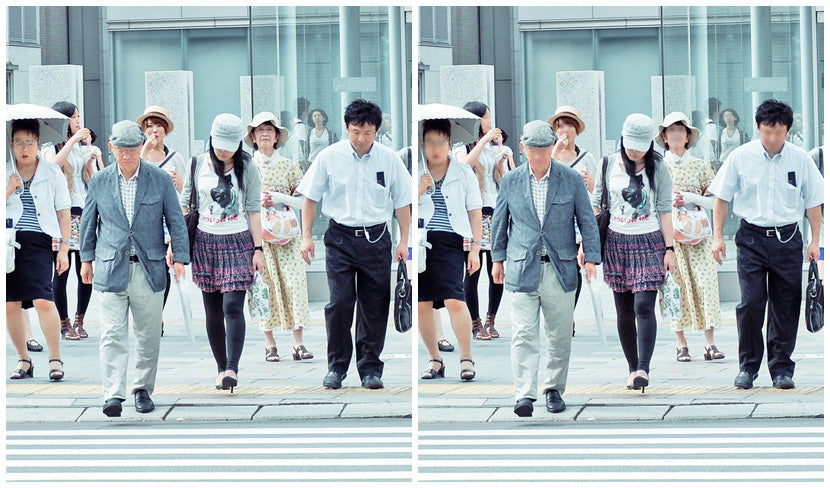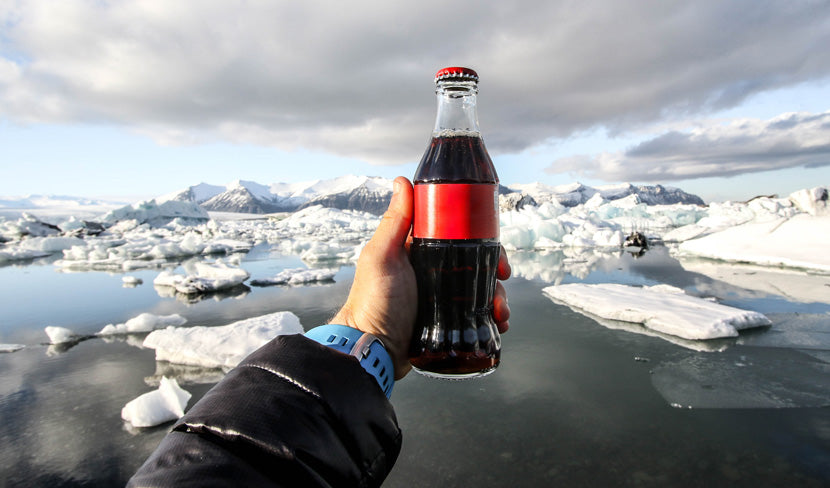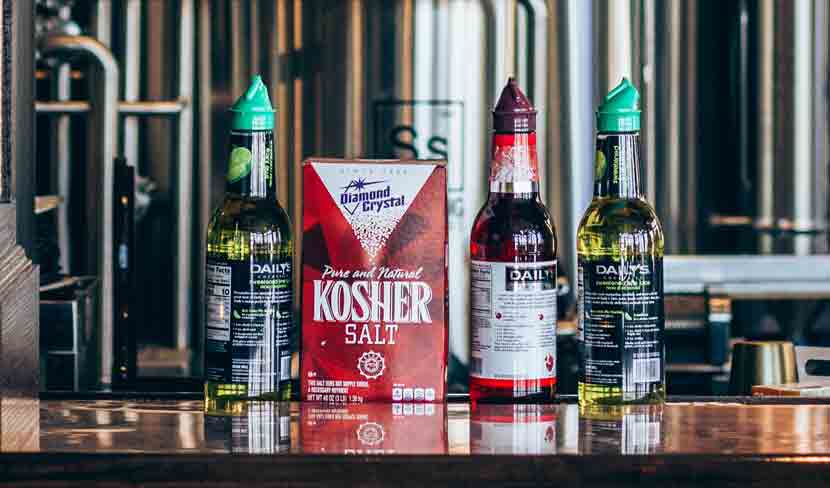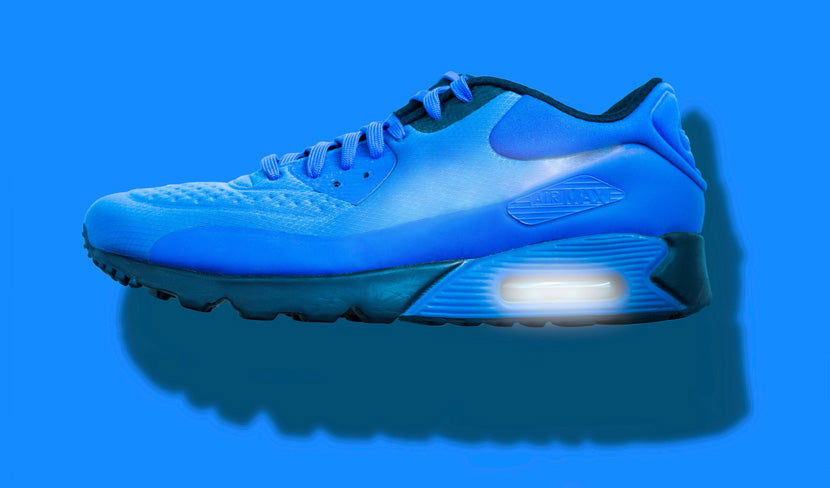Cut back on potential complications and time-consuming photo-editing by keeping these ten things out of the frame of your marketing and product photos.
Have you ever shot a product photo, only to realize later on that the photos don’t meet legal or marketplace requirements?
If so, you’re likely not alone. Sometimes it’s difficult to understand what can be used and what can’t, what can be in the frame and what can’t, or who and where you can or can’t shoot.
A good place to start is to know photographers’ rights as it relates to taking a photo versus using a photo for ecommerce purposes. In a New York Times interview with Mickey H. Osterreicher, the general counsel for the National Press Photographers Association, he notes how, generally, you can photograph anything in a public setting. (Though this may change depending on which country you’re shooting in; it’s always best to do research specific to your shoot.)
Related: When do you need a photography permit?
Once you use the photo for commercial purposes, that’s where the rules can shift depending on what’s in the frame of your photo. In most cases, you may be need a release form for each person in your image or permission from a certain location. Otherwise, the worst-case scenario may happen: a cease-and-desist letter.
But you can easily cut back on those potential hiccups and time-consuming post-processing with this list of ten things to avoid capturing in the frame of your ecommerce and product photos:
1. People’s Faces

When you take photos in a public place, it’s easy to get passersby in the shot — and it’s equally easy for that shot to become unusable. If the image shows someone’s face that reveals their identity, the publisher of the photo is generally required to obtain a signed release from individuals in the image. Otherwise, you may be required to remove the people from the image.
Consider a location that’s less populated so you don’t need releases or extra photo-editing time. And if you can’t void people altogether, remember that you can still use the image if the person’s face is hidden (as in their back facing the camera) or undistinguishable (you can always blur their face or do a Photoshop face swap with an individual who’s granted permission).
2. Children

Similar to avoiding people’s faces in your images, it’s even more important not to take a photo with children in the frame — no matter if their faces are undistinguishable.
If you do have an image with a child, you’re required to have a signed release from the child’s parent or guardian. This could prove difficult and add extra time to meet your deadline, so it’s better to be safe than sorry by completely avoiding children in the shot unless you have the necessary permissions.
3. Logos and Brand Names

Especially in product photography used in marketing and advertising, it’s vital to remember that logos and brand names cannot be included if the image isn’t directly promoting that brand.
Not only can those logos and brand names distract from your image, freelance photographers may not be able to sell those shots to a client or even to a stock website.
How to get around it:
• Position the subject of your photo in front of the logo or brand name.
• Work your own magic in Photoshop to remove the brand.
How to get around it:
• Position the subject of your photo in front of the logo or brand name.
• Work your own magic in Photoshop to remove the brand.
4. Distinguishable Product Characteristics

Even if you’ve edited out the other brand from your photo, there may be some distinguishable product characteristics that you need to address as well.
Think about the iPhone. While you can always remove the apple from the back of the phone and likely be fine, if your image shows the front of the phone, the circle button at the bottom of the phone is the distinguishable characteristic that sets the iPhone apart from other devices. Since the phone is a solid color, this could be a simple fix based on your level of editing expertise.
Another example is the clothing brand Adidas. The three stripes are the distinguishable characteristic that sets it apart from other brands, and this one may not be as easy to edit as others.
While you’re shooting, always ask yourself if you can easily guess what brand a certain background prop is — and if you can quickly come up with the answer, you likely shouldn’t include it in the frame of your photo.
5. License Plates
If you’re taking a photo with a car or if cars are in the background (unrelated to your shoot), the license plate shouldn’t be in the frame of your photos.
Many people — even in images used for personal purposes — tend to remove or blur license plates since they provide information that can identify the owner of the vehicle. If you want to include a car in your photos or can’t remove it from the background, position your subject to cover the license plate or take the photo at an angle that cuts it out of the frame.
What to do when you’ve captured a license plate
- Edit the photo to include a fake license plate number. To make sure you’re not using a potentially valid number, aim to create a series of numbers and/or letters that doesn’t match the format used by the state that issued the license plate.
- Photoshop out or blur the license plate. This should only take a few minutes, based on your level of editing expertise.
6. Distracting and Busy Backgrounds

As a general rule of thumb for taking product photos, you should always avoid a busy background. This can distract from highlighting the product you’re trying to sell, and it could also mean extra hours invested in the editing process.
Plus, 38% of shoppers are more likely to convert if the product’s featured against a plain background. If a distracting background is a concern, less actually may be more in this situation.
If a white background isn’t an option, a great tip to avoid a busy background is to ensure you scout the right location for your photo shoot.
For example, if you’re shooting outside, consider standing from a distance to scan the surroundings of the area to determine if anything unwanted intrudes on your shot.
If you’re still unsure if your shoot location may yield a busy background, here are some questions to ask yourself:
- Could anything in the background compete with the product as the image’s focal point?
- If you’re shooting with a model, is there anything in the background that would look like it’s protruding from his or her head?
- Are there any colors or patterns in the background that might contrast with the product in your image?
7. Price Tags

Similar to certain backgrounds, price tags can be equally as distracting and may even make the photo (and subsequently the product) seem unappealing.
If you can’t remove the price tag, get a different angle of the product that cuts it from your shot. If you can’t avoid it, you may be able to do a general retouch in Photoshop for a quick and easy fix.
8. Public Buildings
Ever heard that you can’t take a photo of the Eiffel Tower at night? That’s because the lights are copyrighted as a work of art. While it may be unlikely that your photo shoot would happen at night with the Eiffel Tower in the background, there are other public buildings and monuments to watch out for worldwide like art museums, sacred places like mosques and temples, and governmental buildings.
To help, use Getty Images’ Intellectual Property Wiki to determine if the building, monument, or landmark is suitable for the intended use of your photographs.
Shopping malls aren’t actually public property, but they are also to be avoided. Shopping malls are privately owned, which makes the simple task of taking a photo solely up to the discretion of the owner.
Usually, you should be able to find signs that will explicitly state whether you can take photos on these premises. It’s always best to contact the mall directly to find out their rules and recommendations.
9. Sports Teams, Logos and Players
Most major sports teams’ names and logos are trademarked, which means that you’re required to ask for permission before using it in your photos — especially if you’re selling something.
So if a Yankees t-shirt pops up in the frame of your image, you’re likely required to seek permission from the MLB before publishing or selling your photography. If the team name or logo is totally unavoidable, spend some time either making them indistinguishable or remove it all together.
Plus, think about this: In most marketing materials — even in the written form — the NFL has names of games trademarked, even down to the variation of ways you can refer to it.
10. Unintended Shadows
Shadows can be a great addition to a photo, but if they’re unnatural or unintended, they can completely alter how you’re presenting a product. In photography, this ultimately boils down to hard shadows vs. soft shadows.
What is a hard shadow?

Hard shadows occur when your source of light is smaller than the product you’re highlighting.
What is a soft shadow?

Soft shadows occur when the source of light is bigger than the product. Ideally, you want to go for a soft shadow — and can do so by shooting outside or near a large window.
But if both of those options aren’t feasible, consider using a flash diffuser. These usually are rather affordable, but if you’re in a pinch, consider using something like a plastic grocery bag to cover your flash.
Pro tip: To avoid unintended shadows indoors, aim to use natural lighting. If you’re outside, schedule your shoot in the early afternoon.
If you want a shadow in your product photo but don’t have the right lighting to create a natural one, you can always add a shadow effect later.
11. Product Packaging
For the most part, packaging can be distracting in any product photo. For example, your photo may have an unintended glare if the product is wrapped with cellophane — either due to your camera’s flash or even the natural lighting bouncing off the material.
The easiest solve for this is to simply remove the product from the packaging. If you do opt for removing the packaging, ensure that the product is clean (if needed) before shooting.
However, removing the product packaging isn’t always needed. If the product comes with premium packaging, then it’s best to include it in the photo as it’s best to highlight the additional flair that comes with the product.
You can also stage a shot of your product with the packaging in the background, as often seen by makeup and cosmetics brands.

The Bottom Line: What to Avoid in Your Product Photos
If you still find yourself unsure if you can take photos at a certain location, always ask to be safe than sorry. And by keeping these nine things to avoid in the frame of your photos in mind, it not only will help you grow as a photographer — but also to ensure your photography work will be profitable and successful.
Nothing to say about these Blog. It looks like you had a really good blog.Best Clipping path service|Car Photo Editing Service
ReplyDeleteYou can also use this Drop Shadow Photoshop Action
ReplyDeleteMore Experience about "clipping path service" from this Blog.
ReplyDeleteVery amazing and excellent post. thanks for sharing...
ReplyDeleteBest Regards,
image masking solution
1. Don't take photos of your product from the front or the side. This will reduce the chances of capturing a good perspective and making your product look good.
ReplyDelete2. Make sure
How to edit newborn photos